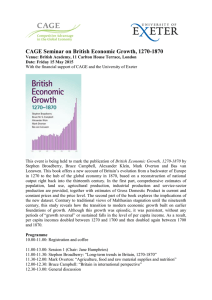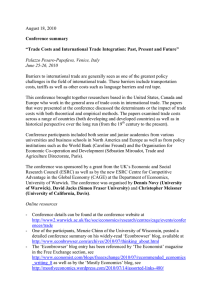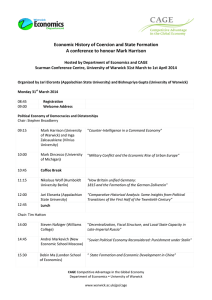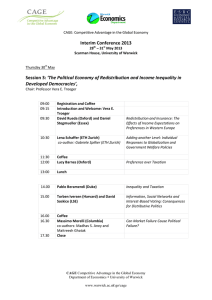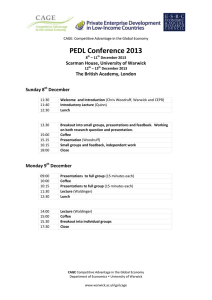Competition cured the “British disease” Nicholas Crafts
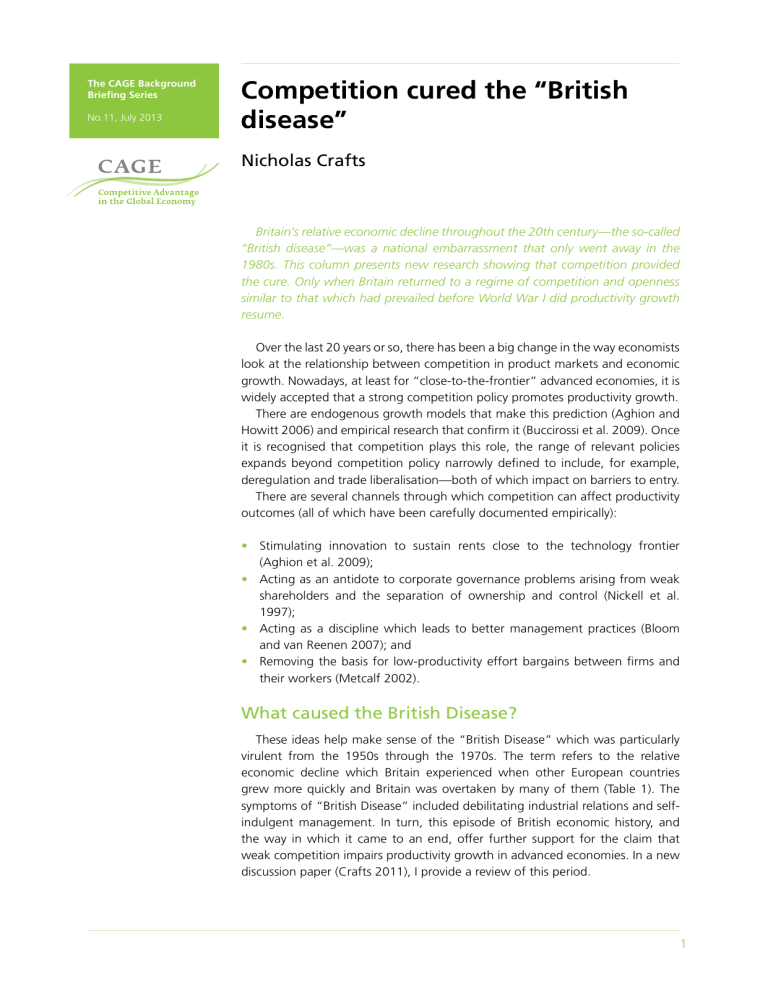
The CAGE Background
Briefing Series
No.11, July 2013
Competition cured the “British disease”
Nicholas Crafts
Britain’s relative economic decline throughout the 20th century—the so-called
“British disease”—was a national embarrassment that only went away in the
1980s. This column presents new research showing that competition provided the cure. Only when Britain returned to a regime of competition and openness similar to that which had prevailed before World War I did productivity growth resume.
Over the last 20 years or so, there has been a big change in the way economists look at the relationship between competition in product markets and economic growth. Nowadays, at least for “close-to-the-frontier” advanced economies, it is widely accepted that a strong competition policy promotes productivity growth.
There are endogenous growth models that make this prediction (Aghion and
Howitt 2006) and empirical research that confirm it (Buccirossi et al. 2009). Once it is recognised that competition plays this role, the range of relevant policies expands beyond competition policy narrowly defined to include, for example, deregulation and trade liberalisation—both of which impact on barriers to entry.
There are several channels through which competition can affect productivity outcomes (all of which have been carefully documented empirically):
• Stimulating innovation to sustain rents close to the technology frontier
(Aghion et al. 2009);
• Acting as an antidote to corporate governance problems arising from weak shareholders and the separation of ownership and control (Nickell et al.
1997);
• Acting as a discipline which leads to better management practices (Bloom and van Reenen 2007); and
• Removing the basis for low-productivity effort bargains between firms and their workers (Metcalf 2002).
What caused the British Disease?
These ideas help make sense of the “British Disease” which was particularly virulent from the 1950s through the 1970s. The term refers to the relative economic decline which Britain experienced when other European countries grew more quickly and Britain was overtaken by many of them (Table 1). The symptoms of “British Disease” included debilitating industrial relations and selfindulgent management. In turn, this episode of British economic history, and the way in which it came to an end, offer further support for the claim that weak competition impairs productivity growth in advanced economies. In a new discussion paper (Crafts 2011), I provide a review of this period.
1
Competition cured the “British disease”
Table 1. Real GDP per head as percentage of other countries
1870
1913
1929
1937
1950
1979
2007
UK/USA
130.5
92.8
79.8
96.7
72.6
70.1
75.4
UK/West Germany
173.5
134.9
135.8
132.7
162.1
86.3
101.4
UK/France
170.0
141.2
116.8
138.6
133.8
90.0
106.1
Note: estimates refer to Germany from 1870 to 1937. Sources: Angus Maddison historical database and West Germany in 2007 calculated from Statistiches Bundesamt Deutschland 2010.
Table 2. Trade costs index
UK-France UK-Germany France-Germany Germany-Italy
1929
1938
1950
1960
100
121
122
122
99
122
142
115
99
133
112
91
110
112
127
101
1970
1980
110
74
105
66
73
55
79
61
1990 70 61 53 56
2000 75 66 61 66
Note : trade costs include all barriers to trade (policy and non-policy) and are derived from estimation of a gravity equation. Source: data underlying Jacks et al. (2011) kindly provided by the authors.
The retreat from competition in the British economy was triggered by the
1930s crisis but was not fully reversed until the 1980s. Early postwar Britain was notable for cartelisation, nationalisation, weak competition policy, and protectionism. Table 2 reports the relatively slow reduction in trade costs for the
UK compared with founder members of the European Economic Community and not until the late 1970s was something approaching free trade restored.
The weakness of competition in product markets interacted with two aspects of British exceptionalism in terms of institutions, namely, corporate governance, and industrial relations. The former was characterised by the absence of strong shareholders and an ineffective market for corporate control, the latter by the presence of craft control, multi-unionism, and legal immunities which underpinned trade-union bargaining power. The evidence is that, in these circumstances, weak competition led to poor productivity outcomes. Competition policy was largely neglected which was clearly a mistake. On the one occasion where a serious reform was made, the Restrictive Practices Act in 1956 which led to the abandonment of collusion in many sectors, there was a significant impact on productivity performance (Symeonidis 2008).
2
Competition cured the “British disease”
The Thatcher experiment
The results of the “Thatcher Experiment” in the 1980s make the case and paved the way for reversing relative economic decline. Competition was much strengthened by ongoing trade liberalisation, deregulation, and discontinuing
1970s’ industrial policy. As competition strengthened, there were major changes in industrial relations which were associated with organisational change, together with divestment and restructuring in large firms.
At the sectoral level, stronger competition and greater openness were correlated with improved productivity performance. As the age of information and communication technology came along, Britain was able to embrace the opportunities associated with rapid diffusion of the new technologies, which required big changes in working practices and management hierarchies, better than its continental-European peer group. This would not have happened with
1970s-style industrial relations and a heavily-regulated service sector.
Some reflections on this story are worth remembering.
• First, it was not just Thatcherism that made the difference. Trade liberalisation was well under way already and the reform of British anti-trust policy was only seriously undertaken by the Labour government in Acts of 1998 and
2002.
• Second, by implication, it is clear that Britain’s failure to sign the Treaty of Rome in 1957 had a substantial cost in terms of its adverse impact on productivity performance.
• Third, although Britain is an egregious example of the long-lasting damage that the 1930s did to supply-side policy, somewhat similar impacts of that financial crisis were felt across the OECD countries.
Fortunately, this time it has been different.
3
Competition cured the “British disease”
References
Aghion, P and P Howitt (2006), “Appropriate Growth Theory: a Unifying
Framework”, Journal of the European Economic Association, 4, 269–314.
Aghion, P, R Blundell, R Griffith, P Howitt, and S Prantl (2009), “The Effects of Entry on Incumbent Innovation and Productivity”, Review of Economics and
Statistics, 91: 20–32.
Bloom, N and J van Reenen (2007), “Measuring and Explaining Management
Practices across Firms and Countries”, Quarterly Journal of Economics, 122:1351–
1408.
Buccirossi, P, L Clari, T Duso, G Spagnolo, and C Vitale (2009), “Competition
Policy and Economic Growth: an Empirical Assessment [1]”, CEPR Discussion
Paper 7470.
Crafts, N (2011), “British Relative Economic Decline Revisited [2]”, CEPR
Discussion PaperNo. 8384.
Jacks, D, C Meissner, and D Novy (2011), “Trade Booms, Trade Busts and Trade
Costs”, Journal of International Economics, 83:185–201.
Metcalf, D (2002), “Unions and Productivity, Financial Performance and
Investment: International Evidence”, London School of Economics Centre for
Economic Performance Discussion Paper 539
Nickell, S, D Nicolitsas, and N Dryden (1997), “What Makes Firms Perform
Well?”, European Economic Review, 41:783–796.
Symeonidis, G (2008), “The Effects of Competition on Wages and Productivity:
Evidence from the UK”, Review of Economics and Statistics, 90:134–146.
4
About CAGE
Established in January 2010, CAGE is a research centre in the Department of
Economics at the University of Warwick. Funded by the Economic and Social
Research Council (ESRC), CAGE is carrying out a five-year programme of innovative research.
The Centre’s research programme is focused on how countries succeed in achieving key economic objectives, such as improving living standards, raising productivity and maintaining international competitiveness, which are central to the economic well-being of their citizens.
CAGE’s research analyses the reasons for economic outcomes both in developed economies such as the UK and emerging economies such as China and India. The
Centre aims to develop a better understanding of how to promote institutions and policies that are conducive to successful economic performance and endeavours to draw lessons for policy-makers from economic history as well as the contemporary world.
This piece first appeared on Voxeu on 5 June 2011.
www.voxeu.org/article/competition-cured-british-disease
© 2013 The University of Warwick.
Published by the Centre for Competitive Advantage in the Global Economy
Department of Economics, University of Warwick, Coventry CV4 7AL www.warwick.ac.uk/cage
Designed and typeset by Soapbox, www.soapbox.co.uk
